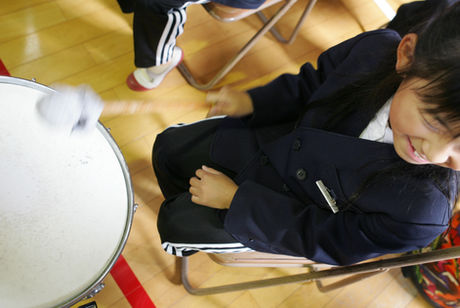Drum Circle for educational field
教育現場でのドラムサークル

drum circle
for Educational Field
教育現場でのドラムサークル
教育現場にドラムサークルを取り入れることは、生徒が協力し合うことを学ぶチャンスを提供し、学習能力や健全な人間関係スキルの向上に役立ちます。
なぜドラムサークルを教育に取り入れるのか?
ドラムサークルを体験することは、ストレス軽減や機敏さの向上、さらには免疫力の向上に役立つことが研究により実証されています。ドラムサークルに参加することで、生徒はより良い人間関係のあり方を体験することができます。教育の場で定期的にドラムサークルを取り入れることで、生徒達の出席率が向上し、より学校を楽しむことができるようになるでしょう。
何より「楽しい」!
ドラムサークルは誰もが共に音楽づくりを体験する一番簡単な方法だと言えます。参加するために音楽的な専門知識は必要ありません。参加すればすぐに一緒に音楽づくりを楽しむことができます。そして何より大切なことは「とても楽しい!」ということです。子ども達はドラムを叩くことが大好きです。ドラムサークルは100%参加型の活動であり、ドラムサークルファシリテーターは、全員で演奏する楽しさを教えてくれます。さらにこの活動は、言語を学習している生徒、身体的・精神的な障害を抱える生徒、そして注意欠陥障害(ADHD)をもつ生徒にも価値のある特別な体験となります。
ドラムサークルでの学び
VMCドラムサークルファシリテーターは、全ての年齢、能力の生徒を対象とした様々な規模の活動を提案することができます。異なる年齢の子ども達が共に活動することで、様々なスキルを高めることができます。3〜4名の小さなグループからクラス全員が参加するグループ、そして全校生徒など数百名を対象とした活動も可能です。例えば、幼児20名が一緒にドラムサークルを体験することで得られるメリットは、「聞きあう力」「言語・非言語の合図を理解する力」「協力して演奏する力」「順番のルールを学ぶ」「身体能力の向上」などがあります。もう一つ例をあげると、中学生200名が共にドラミングを体験することは、「人間関係作り」「多様性の理解」「リーダーシップ教育」などに役立てることができます。ドラムサークルは生徒、教師、保護者、兄弟など全学校関係者が共に参加できる創造的な活動であり、参加者全員が共有できる素晴らしい体験となるでしょう。
ドラムサークルと学習
ドラムサークルは学習に遅れをもつ生徒にも役立てることができます。多くの教師はリズムやチャント、ラップ音楽を用いて数学の理論を教えたり、ドラミングを用いて地理、歴史、社会、科学などの教科を効果的に指導したりしています。また教育者の多くがドラムサークルを教育に取り入れることで、生徒達の社会的能力と人間関係スキルが向上すると言っています。VMCでは教育者を対象としたドラミングの効果的な活用法を学べる研修を提供しています。
新しい自分との出会い
ドラムサークルのファシリテーターにとって何より嬉しい瞬間は、生徒自身が自らの力に気付き、リーダーとして立ち上がる時です。一人の生徒が輪の中心に立ち、緊張の中多くの視線を受けながらも、自らが発する合図の影響力を感じる。この瞬間、生徒は真のリーダーとしての体験を得ることができるのです。このような体験は一人の生徒にとって単なる楽しい、嬉しい体験としてだけではなく、自己肯定感を高めることのできる生涯忘れることのできない学びの体験となるでしょう。教育現場におけるドラムサークルは楽しみながら学び続けることができる機会を提供し、人と人との繋がりをより強くしてくれます。





